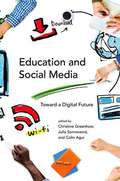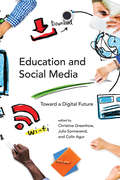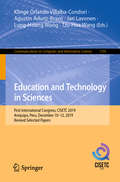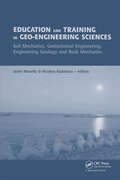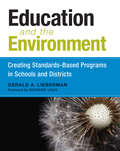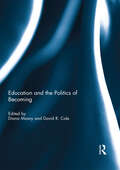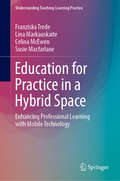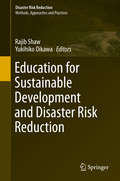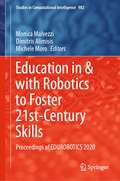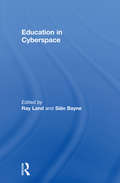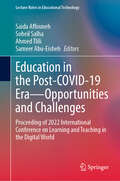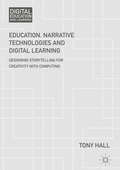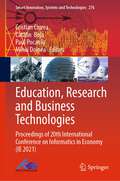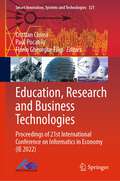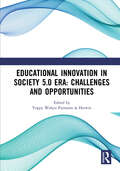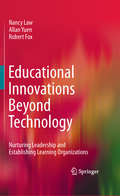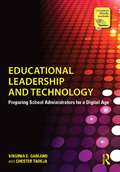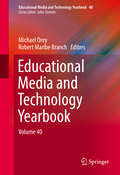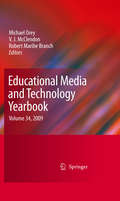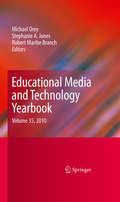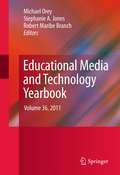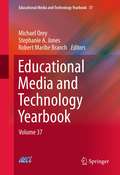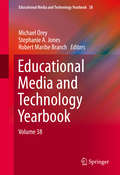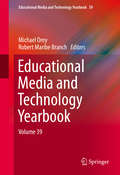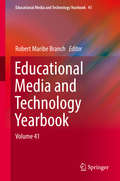- Table View
- List View
Education and Social Media: Toward a Digital Future
by Colin Agur Christine Greenhow Julia SonnevendHow are widely popular social media such as Facebook, Twitter, and Instagram transforming how teachers teach, how kids learn, and the very foundations of education? What controversies surround the integration of social media in students' lives? The past decade has brought increased access to new media, and with this new opportunities and challenges for education. In this book, leading scholars from education, law, communications, sociology, and cultural studies explore the digital transformation now taking place in a variety of educational contexts. The contributors examine such topics as social media usage in schools, online youth communities, and distance learning in developing countries; the disruption of existing educational models of how knowledge is created and shared; privacy; accreditation; and the tension between the new ease of sharing and copyright laws. Case studies examine teaching media in K--12 schools and at universities; tuition-free, open education powered by social media, as practiced by the University of the People; new financial models for higher education; the benefits and challenges of MOOCS (Massive Open Online Courses); social media and teacher education; and the civic and individual advantages of teens' participatory play.ContributorsColin Agur, Jack M. Balkin, Valerie Belair-Gagnon, danah boyd, Nicholas Bramble, David Buckingham, Chris Dede, Benjamin Gleason, Christine Greenhow, Daniel J. H. Greenwood, Jiahang Li, Yite John Lu, Minhtuyen Mai, John Palfrey, Ri Pierce-Grove, Adam Poppe, Shai Reshef, Julia Sonnevend, Mark Warschauer
Education and Social Media: Toward a Digital Future (The John D. and Catherine T. MacArthur Foundation Series on Digital Media and Learning)
by Colin Agur Christine Greenhow Julia SonnevendLeading scholars from a variety of disciplines explore the future of education, including social media usage, new norms of knowledge, privacy, copyright, and MOOCs.How are widely popular social media such as Facebook, Twitter, and Instagram transforming how teachers teach, how kids learn, and the very foundations of education? What controversies surround the integration of social media in students' lives? The past decade has brought increased access to new media, and with this new opportunities and challenges for education. In this book, leading scholars from education, law, communications, sociology, and cultural studies explore the digital transformation now taking place in a variety of educational contexts. The contributors examine such topics as social media usage in schools, online youth communities, and distance learning in developing countries; the disruption of existing educational models of how knowledge is created and shared; privacy; accreditation; and the tension between the new ease of sharing and copyright laws. Case studies examine teaching media in K–12 schools and at universities; tuition-free, open education powered by social media, as practiced by the University of the People; new financial models for higher education; the benefits and challenges of MOOCS (Massive Open Online Courses); social media and teacher education; and the civic and individual advantages of teens' participatory play.ContributorsColin Agur, Jack M. Balkin, Valerie Belair-Gagnon, danah boyd, Nicholas Bramble, David Buckingham, Chris Dede, Benjamin Gleason, Christine Greenhow, Daniel J. H. Greenwood, Jiahang Li, Yite John Lu, Minhtuyen Mai, John Palfrey, Ri Pierce-Grove, Adam Poppe, Shai Reshef, Julia Sonnevend, Mark Warschauer
Education and Technology in Sciences: First International Congress, CISETC 2019, Arequipa, Peru, December 10–12, 2019, Revised Selected Papers (Communications in Computer and Information Science #1191)
by Lung-Hsiang Wong Jari Lavonen Klinge Orlando Villalba-Condori Agustín Aduríz-Bravo Tzu-Hua WangThis book constitutes the refereed proceedings of the First International Congress on Education and Technology in Sciences, CISETC 2019, held in Arequipa, Peru, in December 2019. The 12 full papers presented in the volume were carefully reviewed and selected from 96 submissions. The papers are focused on the two main topics: pedagogical practice in the sciences, focused specificaly on science education; and complementary aspects of science teaching, which considers all the elements that can contribute to science education.
Education and Training in Geo-Engineering Sciences: Soil Mechanics and Geotechnical Engineering, Engineering Geology, Rock Mechanics
by Iacint Manoliu Nicoleta RadulescuCovering a broad range of topics (curricular matters in geo-engineering education, teaching; learning and assessment in geo-engineering education; challenges in geotechnical engineering education; issues in education and training in Engineering Geology; the link university -professional world in geo-engineering, this book will be invaluable to university teachers, academics and professionals involved in education and training in geo-engineering sciences.
Education and the Environment: Creating Standards-Based Programs in Schools and Districts
by Gerald A. LiebermanIn this timely book, curriculum expert Gerald A. Lieberman provides an innovative guide to creating and implementing a new type of environmental education that combines standards-based lessons on English language arts, math, history, and science with community investigations and service learning projects. By connecting academic content with local investigations, environmental study becomes not simply another thing added to the classroom schedule but an engaging, thought-provoking context for learning multiple subjects. The projects outlined in the book further students&’ understanding of the way human and natural &“systems&” interact locally and globally, and provide the next generation with the knowledge necessary for making decisions that will be critical to their future—and ours.
Education and the Politics of Becoming
by Diana MasnyThis collection examines education in the light of a politics of becoming. It takes a non-hierarchical transdisciplinary approach, challenging the macropolitics of pre-established governmental and economic agendas for education. Drawing on the philosophy of Gilles Deleuze and Felix Guattari, the contributors consider questions such as how education might engage a politics of becoming, and how education and becoming function in a society of control. Since Deleuze and Guattari contend that a society is defined by its becomings, its transformations, this collection asks how education, itself a process in becoming, may contribute "collective creations" to a society in continual flux.The chapters bring theory and praxis together, deploying power, affect, cartography, space, relationality, assemblage and multiple literacies in order to experiment with music, art, language, teacher education, curriculum and policy studies. This collection is an innovative resource, creating an encounter with the macropolitics of education, and altering teaching, learning, evaluation and curriculum. This book was originally published as a special issue of Discourse: Studies in the Cultural Politics of Education.
Education for Practice in a Hybrid Space: Enhancing Professional Learning with Mobile Technology (Understanding Teaching-Learning Practice)
by Franziska Trede Lina Markauskaite Celina McEwen Susie MacfarlaneThis book presents a mobile technology capacity building framework that offers academics, students, and practitioners involved in workplace education a deeper understanding of, and practical guidance on, how mobile technology can enhance professional learning. Approaching professional and workplace learning as a hybrid space in which work, learning and technology meet, the book discusses the value of mobile technology in shaping professional education, particularly during student placements.The framework focuses on staying professional and safe, considering issues of time and place, planning learning activities, initiating dialogue, networking, creating learning opportunities on-the-go, and deepening reflection. It is designed to assist students and their educators to use mobile technology knowledgeably and responsibly, and to help bridge the gap between university learning and workplace practice.This book also contributes to a better understanding of the interconnectedness between learning, practice and technology. It demonstrates how to enhance learning and working with mobile technology by drawing on two perspectives: the ‘professional-plus’ and the ‘deliberate professional’.
Education for Sustainable Development and Disaster Risk Reduction
by Rajib Shaw Yukihiko OikawaEducation for Sustainable Development (ESD) and Disaster Risk Reduction Education (DRRE) have overlapping areas of concern focusing on strengthening the link to local communities. In reality, there is significant synergy in ESD and disaster risk reduction (DRR). Both concepts urge looking at the communities, both focus on behavior changes and both call for linking knowledge to action. The Decade of Education for Sustainable Development (DESD) ends in 2014 and the Hyogo Framework for Action (HFA) ends in 2015. Therefore, at this junction, it is important to review the progress made over the past 10 years and to suggest future synergy options. This book is the first attempt to review these two emerging fields and to provide input to the future direction of education. The book has 11 chapters, drawing lessons mainly from Japan and discussing their implications for the world. The first four chapters provide an overview of the ESD-DRR linkage, ESD and its evolution, DRRE and Climate Change Education. These are followed by case studies from ESD practices in Japan, in schools, universities and communities. The primary target groups for this book are students and researchers in the fields of environment, disaster risk reduction and climate change studies. The book provides them with a good idea of the current research trends in the field and furnishes basic knowledge about these vital topics. Another target group comprises practitioners and policy makers, who will be able to apply the knowledge collected here to establishing policy and making decisions.
Education in & with Robotics to Foster 21st-Century Skills: Proceedings of EDUROBOTICS 2020 (Studies in Computational Intelligence #982)
by Dimitris Alimisis Michele Moro Monica MalvezziThis book includes papers presented at the International Conference “Educational Robotics in the Maker Era – EDUROBOTICS 2020”, Online, February 2021.The contributions cover a variety of topics useful for teacher education and for designing learning by making activities for children and youth, with an emphasis on modern low-cost technologies (including block-based programming environments, Do-It-Yourself electronics, 3D printed artifacts, the use of intelligent distributed systems, the IoT technology, and gamification) in formal and informal education settings.This collection of contributions (17 chapters and 2 short papers) provides researchers and practitioners the latest advances in educational robotics in a broader sense focusing on science, technology, engineering, arts, and mathematics (STEAM) education. Teachers and educators at any school level can find insights and inspirations into how educational robotics can promote technological interest and 21st-century skills: creativity, critical thinking, team working, and problem-solving with special emphasis on new emerging making technologies.
Education in Cyberspace
by Ray Land Siân BayneThe use of online learning environments is now widespread, and there is a wealth of literature providing practical advice on how to teach online, develop courses and ensure effective pedagogical practice. What has been frequently overlooked is the insight offered by cyberspace theory, which considers broader social, cultural and theoretical contexts within which new technologies and learning models are situated. This book provides a fresh perspective on current thinking in e-learning. It challenges orthodox assumptions about the role of technology in the teaching and learning of the future, and explores more varied and wider-reaching conceptual frameworks for learning in cyberspace. Featuring the contributions of respected and experienced experts with a wide range of perspectives, Education in Cyberspace will be valued by anyone closely involved in the theory of e-learning and education.
Education in the Post-COVID-19 Era—Opportunities and Challenges: Proceeding of 2022 International Conference on Learning and Teaching in the Digital World (Lecture Notes in Educational Technology)
by Ahmed Tlili Saida Affouneh Soheil Salha Sameer Abu-EishehThis book offers authors’ practices, initiatives, and experiences in sustaining their education during the pandemic from different countries, contexts, and political situations. It provides a future prediction for the education system in the world due to the transformation that happened in the post-COVID-19 era. Each chapter of the book is expected to shed light on different countries describing their education system in the past, present, and future. The readers of the book will be able to learn, compare, and analyze the differences and similarities between the educations offered to learners around the world.The book also presents a new model of e-learning that will help learners, teachers, and educational systems to participate in achieving sustainable development goals. The book introduces several scenarios of types of learning and how to plan, design, and implement them in F2F and online environments.
Education, Narrative Technologies and Digital Learning: Designing Storytelling for Creativity with Computing (Digital Education and Learning)
by Tony HallThis book examines and illustrates the potential of narrative technology, the integration and synthesis of storytelling and digital media in education. Storytelling is a foundational and powerful process in all learning and teaching, and technology is becoming ever more ubiquitous and sophisticated, particularly in its capabilities to mediate and augment creative storytelling. The book begins with a foundational analysis of narrative use in education today, and provides a history of the emergence of narrative technology. It explores how the convergence of high-potential computing and storytelling practices and techniques can be used to enhance education, in particular the design of bespoke, interactive physical learning environments. The contemporary importance of educational design is highlighted throughout the book, which concludes with the SCÉAL design-based research framework as a proposed systematic approach to the design of narrative technology in education. The book will be a valuable resource for educational designers, technologists, teachers and policymakers, especially those with an interest in the design and use of narrative technology in education.
Education, Research and Business Technologies: Proceedings of 20th International Conference on Informatics in Economy (IE 2021) (Smart Innovation, Systems and Technologies #276)
by Cristian Ciurea Paul Pocatilu Cătălin Boja Mihai DoineaThis book includes high-quality research papers presented at 20th International Conference on Informatics in Economy (IE 2021), which is held in Bucharest, Romania during May 2021. The book covers research results in business informatics and related computer science topics, such as IoT, mobile-embedded and multimedia solutions, e-society, enterprise and business solutions, databases and big data, artificial intelligence, data-mining and machine learning, quantitative economics.
Education, Research and Business Technologies: Proceedings of 21st International Conference on Informatics in Economy (IE 2022) (Smart Innovation, Systems and Technologies #321)
by Florin Gheorghe Filip Cristian Ciurea Paul PocatiluThis book includes high-quality research papers presented at 21st International Conference on Informatics in Economy (IE 2022), which is held in Bucharest, Romania, during May 2022. This book covers research results in business informatics and related computer science topics, such as IoT, mobile-embedded and multimedia solutions, e-society, enterprise and business solutions, databases and big data, artificial intelligence, data mining and machine learning, quantitative economics.
Educational Innovation in Society 5.0 Era: Proceedings of the 4th International Conference on Current Issues in Education (ICCIE 2020), Yogyakarta, Indonesia, 3 - 4 October 2020
by Yoppy Wahyu PurnomoThis book consists of a selection of papers that discuss the challenges in the increasingly complex world of education and various educational problems such as moral degradation, lack of literacy, pedagogical curriculum and innovation, educational technology. Moreover, the book provides papers that deal with educational innovation in the era of Society 5.0, with a view to discuss and resolve various social challenges, issues, and problems relating to educators, students, the dynamics of the education system, and social dynamics. The subject areas treated in this book are: Character Education in Society 5.0 Era, Multiliteracy Education in Society 5.0 Era, Early Childhood Education in Society 5.0 Era, Inclusive Education in Society 5.0 Era, Curriculum, Media and Educational Technology for Primary Education in Society 5.0 Era, Joyful and Meaningful Learning in Society 5.0 Era, and HOTS in Society 5.0 Era. This book will help educators, stakeholders, and also parents to cope with the challenges in education.
Educational Innovations Beyond Technology
by Robert Fox Allan Yuen Nancy LawThe text explores the concept of innovation, and analyse and compare different dimensions of innovation found in the various case studies; the transfer of innovation and the mechanisms of change; on an innovative online case study database on education innovations that has been designed to be used by education practitioners to support organizational leadership, international collaboration and reflective practice in the Asia Pacific Economic Cooperation (APEC) eEducation Leadership initiative; on a project aimed to support the establishment of communities of practice for education practitioners facilitated through an extendable online database that can be used to contribute and share case studies of their own ICT-supported pedagogical innovations. It discusses roles of the teacher and the anticipated changes to the education profession at a system level, in the coming decade on the basis of emerging changes observed in the case studies, and leadership issues at the school level. The book analyses change mechanisms for different kinds of innovation and how different contextual and cultural factors interact to bring about the changes observed.
Educational Leadership and Technology: Preparing School Administrators for a Digital Age
by Virginia E. Garland Chester TadejaProviding models of exemplary use and the latest research, Educational Leadership and Technology reveals the transformational power of emerging technologies to improve student learning, and explores how leaders can bring about this technology integration. This book provides an overview of roles and strategies expected of effective school leaders, as well as some of the complex issues they face. Authors Garland and Tadeja offer a critical analysis of today's emerging technology, while also addressing the need for collaborative efforts of parents, community, and students to implement technologies effectively. Special Features Include: Full integration of National Technology Standards for Administrators (NETS.A) and the National Education Technology Plan (NETP). Leader reflections from practicing school administrators that provide context of real-world scenarios. "Tips for School Leaders" and end-of-chapter questions that encourage student engagement with the text. "School Administrator's Technology Leadership Self-Assessment," a unique and impartial survey in each chapter with self-scoring guide that helps readers determine their technology use and readiness for implementation. A robust companion website with PowerPoint Slides, strategies, and links to website and video resources which will reflect changes in technology, policy, and practice. Discussion of the newest and emerging technologies, including Cloudware, social media, virtual manipulatives, and e-games. Educational Leadership and Technology is an important resource for new and aspiring elementary, middle, and high school principals as well as superintendents and technology coordinators.
Educational Media and Technology Yearbook
by Robert Maribe Branch Michael OreyThe Educational Media and Technology Yearbook has become a standard reference in many libraries and professional collections. Examined in relation to its comp- ion volumes of the past, it provides a valuable historical record of current ideas and developments in the ?eld. Part I, "Trends and Issues," presents an array of chapters that develop some of the current themes listed above, in addition to others. Part II, "Library and Information Science," concentrates upon chapters of special relevance to K-12 education, library science education, school learning resources, and various types of library and media centers--school, public, and academic among others. In Part III, "Leadership Pro?les," authors provide biographical sketches of the careers of instructional technology leaders. Part IV, "Organizations and Associations in North America," and Part V, "Graduate Programs in North America," are, resp- tively, directories of instructional technology-related organizations and institutions of higher learning offering degrees in related ?elds. Finally, Part VI, the "Medi- raphy," presents an annotated listing of selected current publications related to the ?eld. For a number of years we have worked together as editors and the sixth with Dr. Michael Orey as the senior editor. Last year as the senior editor, Orey decided to try and come up with a list of the top programs rather than just the list of all the programs. This has proven to be problematic. First of all, bias exists when we are rating a ?eld in which our program is within those to be rated.
Educational Media and Technology Yearbook, Volume 34
by Robert Maribe Branch V. J. Mcclendon Michael OreyThe Educational Media and Technology Yearbook is dedicated to theoretical, empirical and practical approaches to educational media development. All chapters are invited and selected based on a variety of strategies to determine current trends and issues in the field. The 2009 edition will highlight innovative Trends and Issues in Learning Design and Technology, Trends and Issues in Information and Library Science, and features a section that lists and describes Media Related Organizations and Associations in North America. <P><P> The Educational Media and Technology Yearbook, a scholarly resource for a highly specialized professional community, is an official publication of the AECT and has been published annually for 33 years.
Educational Media and Technology Yearbook, Volume 35
by Robert Maribe Branch Michael Orey Stephanie A. JonesThe evolution of educational technology has seen a shift from hardware and software to tactics and techniques, as the 2010 edition of the Educational Media and Technology Yearbook makes abundantly clear. As in previous years, it offers the reader a snapshot of the moment and a look ahead to issues most likely to shape the immediate future--an array as varied as the use of social networking sites in learning, new collaborations between media specialists and non-teaching school personnel, and the emerging discipline of Human Performance Technology. Here are ideas that are not only intellectually intriguing but also practical and practice-building, inspiring educators using computer technology to move beyond traditional teaching roles toward learning design. Included in the 2010 Yearbook: Salient issues in learning, design, and technology, such as the critical part school leadership plays in instructors' acceptance or rejection of technology, New trends in library and information science, including the role of school library media centers in preventing cyberbullying, This year's leadership profiles: Jerrold Kemp, author of Designing Effective Instruction; W. Michael Reed, accomplished, dedicated, and recognized educator in instructional technology, A worldwide directory of current professional associations and organizations in learning design, technology, information, and library science, Up-to-date listings of graduate program in these fields, rated using a variety of criteria, Special mediagraphy section featuring journals, ERIC documents, and media-related publications in specialized areas, including distance education, simulation/virtual reality, artificial intelligence, special education, and professional development. Academics in learning design and technology, and information and library science will welcome the latest edition of the Educational Media and Technology Yearbook as a reference, idea book, and a panoramic study of where we are now.
Educational Media and Technology Yearbook, Volume 36
by Robert Maribe Branch Michael Orey Stephanie A. JonesThe Educational Media and Technology Yearbook is dedicated to theoretical, empirical and practical approaches to educational media development. All chapters are invited and selected based on a variety of strategies to determine current trends and issues in the field. The 2011 edition will highlight innovative Trends and Issues in Learning Design and Technology, Trends and Issues in Information and Library Science, and features a sections that list and describe Media Related Organizations and Associations in North America, departments in the allied fields, and a listing of journals in the field.<P><P> The Educational Media and Technology Yearbook, a scholarly resource for a highly specialized professional community, is an official publication of the AECT and has been published annually for 35 years.
Educational Media and Technology Yearbook, Volume 37
by Robert Maribe Branch Michael Orey Stephanie A. Jones As digital devices play a more critical role in daily life than ever, more opportunities arise for innovative learning technologies—a trend on full display in the Educational Media and Technology Yearbook for 2012. This latest edition, volume 37, from the Association for Education, Communication, and Technology (AECT) notes the most current trends in the field of learning design and technology, taking into account the implications for both formal and informal learning. The majority of articles train their focus on graduate and professional goals, including an analysis of doctoral programs in educational technology and new collaborative learning platforms. Library science is a featured component of this analysis and Library Science programs are featured prominently in this analysis. Mediagraphy and profiles of leaders in the field are also included.
Educational Media and Technology Yearbook, Volume 38
by Robert Maribe Branch Michael Orey Stephanie A. JonesThe latest edition of the Educational Media and Technology Yearbook, from the Association for Education, Communication and Technology (AECT), notes the most current trends in the field of learning design and technology, taking into account the implications for both formal and informal learning. Pivotal research and discussion surrounding educational trends, leadership, organizations and programs have all been updated from volume 37. Chapters train their focus on graduate and professional goals, including an analysis of doctoral programs in educational technology and new collaborative learning platforms. Library science is a featured component of this analysis and Library Science programs are featured prominently in this analysis. This edition also features new content on mediagraphy.
Educational Media and Technology Yearbook, Volume 39
by Robert Maribe Branch Michael OreyThis book is an annual publication entering its 40th year. The series represents current trend and issues in the field of educational communications and technology, journals and other periodicals associated with the field, and the academic programs that prepare instructional technology professionals. Springer has been the publisher for the series, in cooperation with the Association for Educational Communications and Technology, for the past four years. Volume 39 will feature a section on Information Studies, in addition to updated information about programs and a new ranking of the top academic degree programs in the field of Learning, Design, and Technology.
Educational Media and Technology Yearbook: Volume 37 (Educational Media And Technology Yearbook Ser. #39)
by Robert Maribe BranchThe Educational Media and Technology Yearbook has become a standard reference in many libraries and professional collections. It provides a valuable historical record of current ideas and developments in the field. Part One of this updated volume, “Trends and Issues in Learning, Design, and Technology,” presents an array of chapters that develop some of the current themes listed above, in addition to others. In Part Two, “Leadership Profiles,” authors provide biographical sketches of the careers of instructional technology leaders. Part Three, “Organizations and Associations in North America,” and Part Four, “Graduate Programs,” are, respectively, directories of instructional technology-related organizations and institutions of higher learning offering degrees in related fields. Finally, Part Five, the “Mediagraphy,” presents an annotated listing of selected current publications related to the field.
